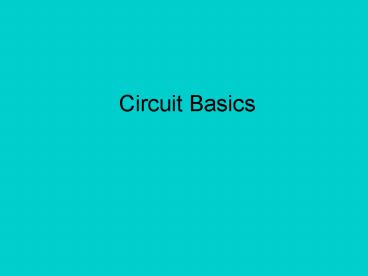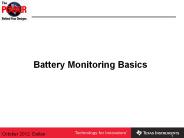Circuit Basics - PowerPoint PPT Presentation
1 / 25
Title:
Circuit Basics
Description:
ampere of current. One volt of electromotive force will cause one ampere to flow ... I=Current through resistor, amperes. R=Resistance, ohms. I=E/R R=E/I. Power ... – PowerPoint PPT presentation
Number of Views:55
Avg rating:3.0/5.0
Title: Circuit Basics
1
Circuit Basics
2
Conduction of Electricity in Solid Materials
Conductivity is determined by the energy band
structure of the material
3
Current and Electromotive Force
- Electromotive force drives electrons to move
through a conductor. - Current is the flow of electric charges.
- One coulomb of charge is approximately
6.24x10E18 - electrons.
- A flow rate of one coulomb per second
produces one - ampere of current.
- One volt of electromotive force will cause
one ampere to flow - through a resistance of one ohm.
4
Some Sources of Electromotive Force
- Generators
- Batteries
- Solar Cells
- Thermocouples
- Piezoelectric Materials
5
Conventional Current VS Electron Flow
6
Ohms Law
- EIR
- EVoltage across resistor, volts
- ICurrent through resistor, amperes
- RResistance, ohms
- IE/R RE/I
7
Power
8
Series and Parallel Resistors
9
Series and ParallelCircuits
- In a series circuit, the current in every
element is the same. - In a parallel circuit, the voltage across every
element is the same.
10
Kirchoffs Voltage Law
- The sum of all voltages around a closed
- loop equals zero.
- Potential rises are taken as positive.
- Potential drops are taken as negative.
- The net sum must be zero.
11
Voltage Law Example
12
Kirchoffs Current Law
- The sum of all currents entering a node
- equals zero.
- Currents entering are taken as positive.
- Currents exiting are taken as negative.
- The net sum must be zero.
13
Current Law Example
14
Thevenins Theorem
- Any black box containing only voltage sources,
- current sources, and resistors can be converted
to a - Thevenin equivalent circuit.
Find open circuit voltage Voc and short circuit
current Isc. VthVoc, RthVoc/Isc
15
Nortons Theorem
Any
black box containing only voltage sources,
current sources, and resistors can be converted
to a Norton equivalent circuit.
Find short circuit current Isc and open
circuit voltage Voc. InoIsc, RnoVoc/Isc
16
Superposition Principle
- The superposition principle states
- that the total current in any branch of a
- linear circuit equals the algebraic sum of the
currents produced by each source acting
separately throughout the circuit.
Procedure Set all voltage and current sources to
zero, except for one. Calculate the branch
currents resulting from of that source. Repeat
with all sources. In each branch, sum the
currents due to the individual sources. Note
Zeroed voltage sourcesshort circuit elements
Zeroed current sourcesopen circuit elements
17
Circuit Analysis Methods
- KVL?Mesh (or Loop) Analysis
- KCL?Nodal Analysis
- ?
- Simultaneous Equations
- Superposition Principle
- Thevenins Nortons Theorems
- ?
- Reduction Simplification
18
Capacitors
- Capacitors store energy in the electric field
between two closely - spaced conducting plates.
19
Inductors
Inductors store energy in the magnetic field
surrounding a conductor
20
Series and Parallel Equivalents
21
The Transformer
The transformer converts AC voltages and currents
from one level to another according to its turns
ratio NNp/Ns.
IpIs/N
VsVp/N
A step-down transformer showing
magnetizing flux in the core
22
Transformers
Two windings
Three windings
Step down
23
Teslas CoilA Resonant Transformer
24
Some Symbols (more later)
25
Circuit Simulation
- Powerful PC software tools are available to
assist with the design and analysis of circuits. - Spice is one of the most popular.
- I will use LTSPICE (SwCADIII) to demonstrate
circuit concepts in class. - SwCADIII is also available for your personal use.































